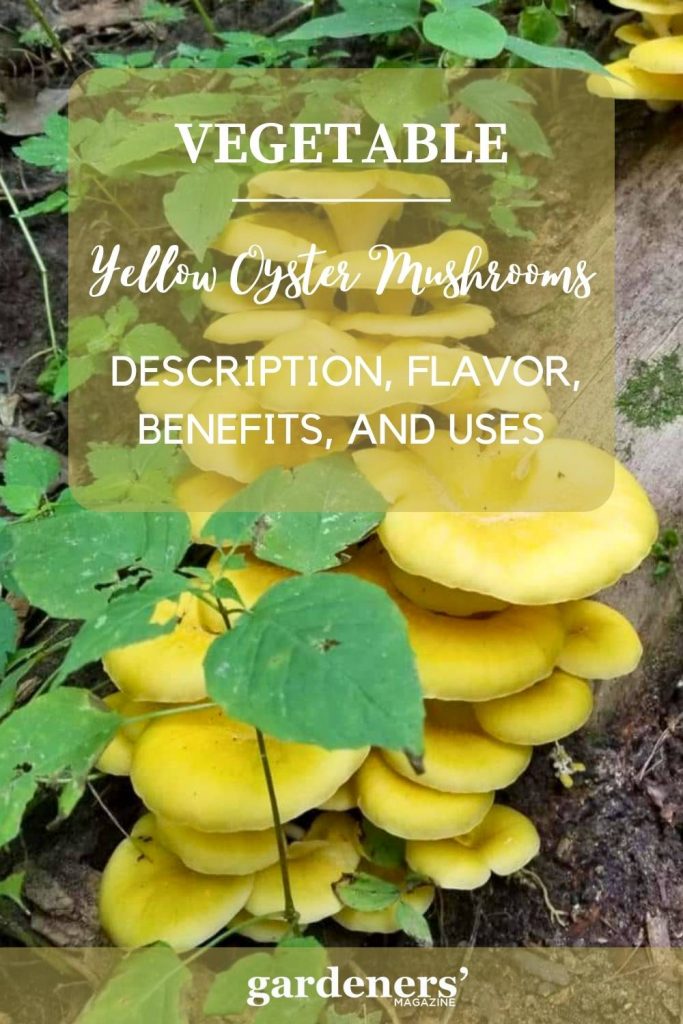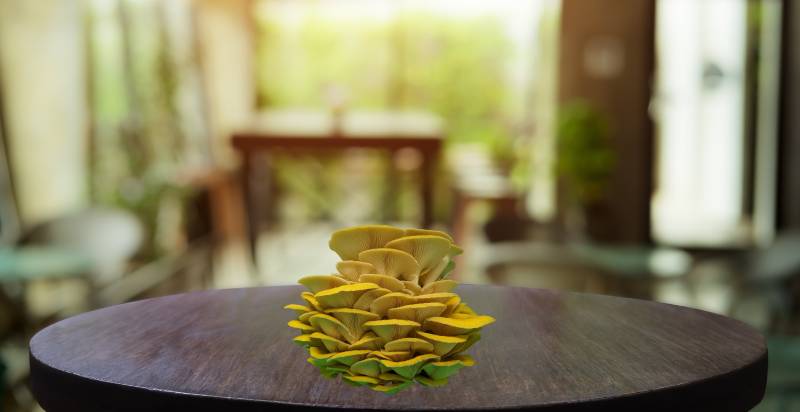Yellow Oyster mushrooms are among the most popular mushroom varieties due to their unique taste and texture. They have a sweet, earthy flavor and crunchy texture, making them ideal for stir-fries, soups, and sauces. Additionally, they have numerous health benefits, such as providing antioxidants, helping to reduce inflammation, improving digestion, boosting the immune system, and more. This article will discuss what yellow oyster mushrooms are, how to cook with them, their nutritional facts and values, and some potential health benefits.
What Are Yellow Oyster Mushrooms?
Yellow oyster mushrooms are members of the Pleurotus family of fungi which includes several species belonging to various genera, including Pleurotus, Agaricus, and Flammulina. They typically grow in clusters on dead or decaying hardwood trees like oak, beech, maple, and elm. Wild yellow oyster mushrooms are usually light yellow to yellow-orange with a convex cap ranging from 2 to 5 inches (5 to 12 cm) wide.

History and Origin of Yellow Oyster Mushrooms
The yellow oyster mushroom (Pleurotus citrinopileatus) is an edible fungus native to East Asia. It has been used in Chinese cooking for centuries and was introduced to Europe during the late 19th century. The mushroom is highly prized for its flavor and texture. Yellow oyster mushrooms are cultivated on a large scale in China, Japan, Korea, and Taiwan. They are also grown commercially in the United States and Europe. The mushroom grows on wood logs or straw, forming large yellowish caps with a white stem. It has a slightly sweet flavor and is often used in stir-fries or soups.
The yellow oyster mushroom’s Latin name translates to “citrus,” which means “lemon,” referring to the mushroom’s characteristic yellow color. Due to its seasonal availability, it is also known as the golden oyster mushroom or the summer oyster mushroom. The yellow oyster mushroom’s popularity has grown in recent years due to its culinary uses, health benefits, and environmental sustainability. It is now grown in many parts of the world, including North America, and is enjoyed by many people for its flavor and versatility in dishes.
Description of the Yellow Oyster Mushrooms
Yellow Oyster Mushrooms (Pleurotus citrinopileatus) are small mushrooms that grow in clusters on hardwood logs and stumps. They have a yellowish-white cap, typically 2-4 cm in diameter, with yellow to white gills underneath. The stems of the mushrooms are short and thin, usually measuring 1-2 cm in length.
The flesh of the Yellow Oyster Mushrooms is firm and white, with a mild flavor described as “slightly sweet” or “nutty.” These mushrooms can be cooked in various ways, including sautéed, grilled, and incorporated into soups or other dishes.
Flavor Profile of Yellow Oyster Mushrooms
Yellow Oyster Mushrooms have a mild flavor that is slightly sweet and nutty. They pair well with other vegetables, herbs, and spices. Their texture is soft when cooked and can be used in everything from soups to stir-fries. They are also a great way to flavor salads or pasta dishes. For the health-conscious, Yellow Oyster Mushrooms are a great source of iron, protein, and dietary fiber. They also contain essential vitamins and minerals that help promote good overall health. With their subtle flavor and unique texture, Yellow Oyster Mushrooms are a versatile ingredient for any meal.
Nutritional Facts & Values of Yellow Oyster Mushrooms
Yellow oyster mushrooms are low in calories but high in fiber and protein. They contain essential vitamins and minerals such as potassium, zinc, magnesium, iron, copper, manganese, phosphorus, and Vitamin B12. These mushrooms also contain antioxidants, which can help protect against free radical damage and reduce inflammation.
Potential Health Benefits of Yellow Oyster Mushrooms
Yellow oyster mushrooms are a great source of nutrients that can provide many health benefits. They may help to improve digestion, boost the immune system, reduce inflammation, lower cholesterol levels, and even prevent certain types of cancer. Additionally, they are a good source of essential vitamins and minerals, which can help to promote overall health and well-being.
Cultivation of the Yellow Oyster Mushrooms
After selecting a suitable substrate and preparing the spawn, you can cultivate the Yellow Oyster Mushrooms. The best temperature for growing Yellow Oysters is between 21-25°C with high humidity levels of 80-90%. You can use either plastic bags or jars to grow your mushrooms.
For both methods, first assemble all the necessary supplies, which include:
- Spawn for Yellow Oyster Mushroom
- Substrates, such as sawdust or straw
- Plastic bags/jars with lids
- Gloves and a mask to protect yourself from contamination.
Start by filling your substrate into plastic bags or jars. Then add the spawn to the substrate and mix well to distribute the spawn evenly. Close the bag or jar with its lid and make sure it is airtight to keep out any contaminants. Place your bags/jars in a dark, warm location with 80-90% humidity levels. Allow the mushrooms to grow for 14-21 days until they are fully developed and ready to be harvested. When harvesting, handle the mushrooms gently to avoid damage.
After harvesting, you can store the mushrooms in a cool place and enjoy them for up to two weeks. You can also use the mushrooms by drying or preserving them with salt, oil, and vinegar. With proper care and cultivation of Yellow Oyster Mushrooms, you can enjoy fresh and delicious mushrooms in no time.
Harvesting of the Yellow Oyster Mushrooms
The harvesting of the yellow oyster mushrooms begins after 3-4 weeks when the mushroom primordia (button) are formed. The mushrooms should be harvested before they mature and turn into full-sized fruit bodies. Once a week, inspect your growing substrate for signs of mushrooms ready for harvest; when you see the small button mushrooms appear at the edges of the blocks or bags, it is time to harvest.
The mushrooms can be harvested using a sharp knife or scissors. Cut the small mushrooms off at the base and collect them in a paper bag or tray. Remove the substrate undisturbed so new fruit bodies can form, and additional harvests can be made from this same block or bag. When harvesting, wear gloves to protect yourself from the sharp edges of the mushrooms.
Where Do Yellow Oyster Mushrooms Grow?
Yellow oyster mushrooms are found worldwide, but they thrive best in temperate climates. In North and Central America, yellow oyster mushrooms have been spotted in parts of Canada, the United States, Mexico, Guatemala, and Costa Rica. They can also be found throughout Europe, from Norway to Spain; some countries, such as France, are now taking advantage of their culinary potential.
In Asia, these mushrooms are present in Japan, Korea, China, and India, while South Africa has its fair share of yellow oyster mushroom colonies. There has even been a report that some have been spotted growing on the slopes of Mt Kilimanjaro! Regardless of where they grow, knowing local laws or regulations concerning foraging and harvesting these mushrooms is still important. Remember to always collect responsibly with caution, respect, and care.

What is the best way to Store Yellow Oyster Mushrooms?
The best way to store Yellow Oyster Mushrooms is to keep them in the refrigerator. Please place them in a paper or plastic bag with holes punched so air can circulate. The mushrooms should be used within five days of purchase for optimal freshness and flavor.
If you need to store them longer than five days, wrap them loosely in a damp cloth and store them in the refrigerator for up to two weeks. For longer storage, oyster mushrooms can be frozen. Please place them in an airtight container or freezer bag and freeze them for up to six months. Thaw before cooking as you would with any other frozen food item.
Finally, avoid storing yellow oyster mushrooms in plastic bags or containers for long periods, which can cause them to spoil faster. It is also important to store oyster mushrooms away from other vegetables as the strong flavor of the mushrooms may affect the taste of other produce.
How can Yellow Oyster Mushrooms be used in Recipes with other Fruits and Vegetables?
Yellow Oyster mushrooms are a delicious addition to many recipes that feature fruits and vegetables. They can be sautéed with onions, garlic, and peppers for a simple side dish or added to stir-fries and soups for extra texture and flavor. Yellow Oyster mushrooms also pair well with other seasonal produce such as broccoli, corn, squash, potatoes, and apples.
They can be used to prepare a vegetarian version of classic dishes such as macaroni and cheese gratins with roasted vegetables or risotto primavera. For more creative recipes, try mixing diced yellow oyster mushrooms with other fruit and vegetable combinations for salads, relishes, chutneys, or omelets. The possibilities are endless! Experimenting with different flavors and textures will help create unique and flavorful dishes.
Conclusion
Yellow oyster mushrooms are a versatile, flavorful addition to any recipe. They can be stored in the refrigerator or frozen for longer-term use. They should be cooked thoroughly and paired with other fruits and vegetables for added flavor and texture when adding them to recipes. With some experimentation, these juicy yellow mushrooms can become integral to many delicious dishes.
- Everything You Wanted to Know About Red Tamarillos - June 2, 2025
- A Guide to Tulips: Everything You Need to Know & More… - June 2, 2025
- Guanabana: Description, Flavor, Benefits, And Uses - May 27, 2025

10 thoughts on “Yellow Oyster Mushrooms: Description, Flavor, Benefits, And Uses”
Comments are closed.